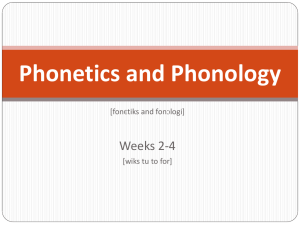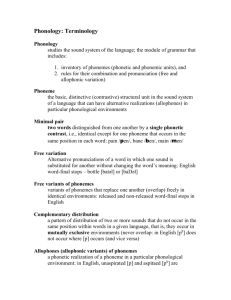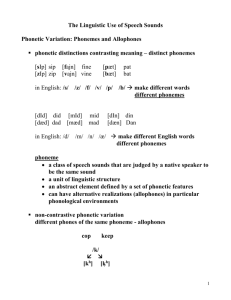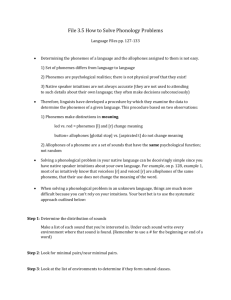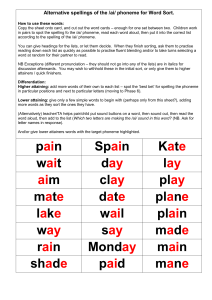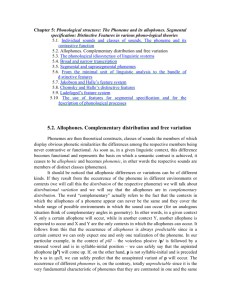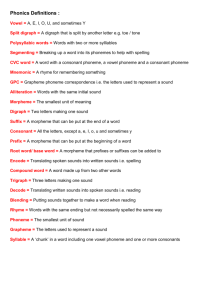docx
advertisement
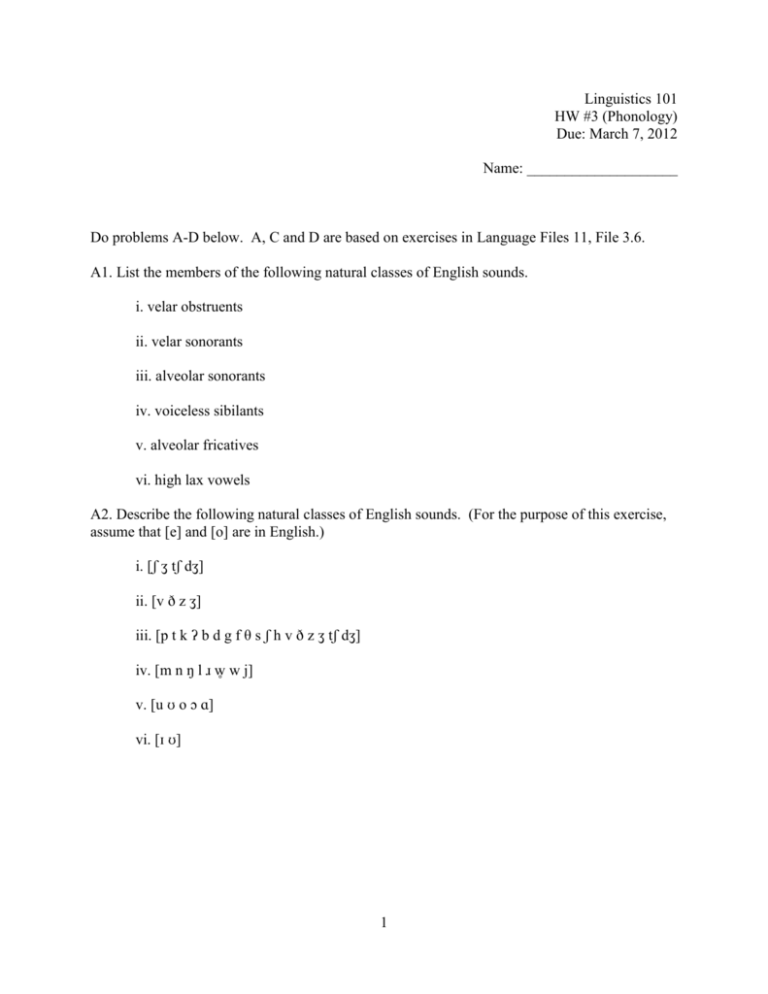
Linguistics 101 HW #3 (Phonology) Due: March 7, 2012 Name: ____________________ Do problems A-D below. A, C and D are based on exercises in Language Files 11, File 3.6. A1. List the members of the following natural classes of English sounds. i. velar obstruents ii. velar sonorants iii. alveolar sonorants iv. voiceless sibilants v. alveolar fricatives vi. high lax vowels A2. Describe the following natural classes of English sounds. (For the purpose of this exercise, assume that [e] and [o] are in English.) i. [ʃ ʒ tʃ dʒ] ii. [v ð z ʒ] iii. [p t k ʔ b d g f θ s ʃ h v ð z ʒ tʃ dʒ] iv. [m n ŋ l ɹ w̥ w j] v. [u ʊ o ɔ ɑ] vi. [ɪ ʊ] 1 B. Based on 3.07 in Frommer, Paul & Edward Finegan (2008) Looking at Languages: a Workbook in Elementary Linguistics, 4th edition. Examine the distribution of [s] and [z] in Spanish and answer the questions below. Note that [ɲ] is a voiced, palatal nasal. Also note that Spanish contains both a voiced alveolar trill [r] and a voiced alveolar flap [ɾ]. [mizmo] [este] [izla] [aspiɾas] [fosko] [lasuɲas] [lozlaβios] [lazmanos] [laspelotas] [losaɾkos] [loskaros] [lostamales] ‘same’ ‘this’ ‘island’ ‘you seek’ ‘irritable’ ‘the fingernails’ ‘the lips’ ‘the hands’ ‘the balls’ ‘the arches’ ‘the cars’ ‘the tamales’ [loseɾmanos] [lazletɾas] [ezmoɾeno] [esamaɾijo] [ezneɣɾo] [espuɾo] [dosperos] [dosoɾuɣas] [dostapetas] [dozlutʃas] [dosizlas] [doskesos] ‘the brothers’ ‘the letters’ ‘it’s brown’ ‘it’s yellow’ ‘it’s black’ ‘it’s clean’ ‘two dogs’ ‘two caterpillars’ ‘two rugs’ ‘two fights’ ‘two islands’ ‘two cheeses’ a) Are there any minimal pairs for the sounds [s] and [z]? If yes, list them. b) What is the distribution type for the sounds [s] and [z] in Spanish? c) In Spanish, are [s] and [z] allophones of the same phoneme, or are they allophones of a different phoneme? d) If [s] and [z] are allophones of the same phoneme, what is the phoneme and why? e) If [s] and [z] are allophones of the same phoneme, write the rules showing their distribution using the format used in class. 2 C. Based on File 3.6, #35 (p. 143). In the data below from Spanish, you will first examine the distribution of the voiced bilabial fricative [β] compared to [b], and then the distribution of the voiced velar fricative [ɣ] compared to [g]. Answer the questions below. [bino] [diβino] [kaβo] [suβteraneo] [bɾotaɾ] [imbjeɾno] [amiɣo] ‘he came’ ‘divine’ ‘end’ ‘subterranean’ ‘to sprout’ ‘winter’ ‘friend’ [uβa] [golpe] [gato] [aɣo] [iɣaðo] [teŋgo] [leɣal] ‘grape’ ‘a hit’ ‘cat’ ‘I do’ ‘liver’ ‘I have’ ‘legal’ [siɣlo] [pweβlo] [laðɾon] [kaβɾa] [loɣɾaɾ] ‘century’ ‘village’ ‘thief’ ‘goat’ ‘to achieve’ a) Are there any minimal pairs for the sounds [β] and [b]? If yes, list them. b) What is the distribution type for the sounds [β] and [b] in Spanish? c) In Spanish, are [β] and [b] allophones of the same phoneme, or are they allophones of a different phoneme? d) If [β] and [b] are allophones of the same phoneme, what is the phoneme and why? e) If [β] and [b] are allophones of the same phoneme, write the rules showing their distribution using the format used in class. 3 f) Are there any minimal pairs for the sounds [ɣ] and [g]? If yes, list them. g) What is the distribution type for the sounds [ɣ] and [g] in Spanish? h) In Spanish, are [ɣ] and [g] allophones of the same phoneme, or are they allophones of a different phoneme? i) If [ɣ] and [g] are allophones of the same phoneme, what is the phoneme and why? j) If [ɣ] and [g] are allophones of the same phoneme, write the rules showing their distribution using the format used in class. D. Consider the rules you wrote in Ce, Cj, and in class for File 3.6, #28. Combine these rules into two rules by using features rather than specific sounds. Hint 1: your second rule should be the elsewhere rule. Hint 2: If your rules have different conditioning environment, you may need to rethink some of them. Can you simplify any of them and still capture the data? 4
